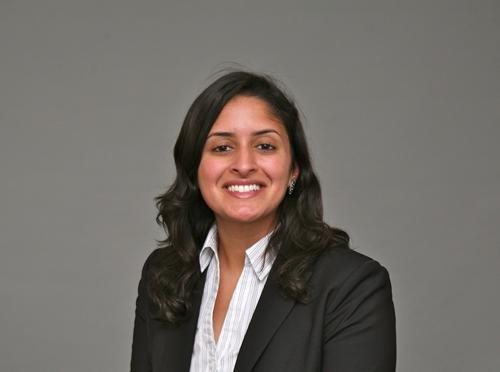
Assistant Professor of Engineering
Credit: Amy Simmons/Brown University
A soldier wounded in combat faces more enemies than the ones on the other side of the battle lines. For lacerating injuries, common on the battlefield, three of the most prominent enemies are bleeding, inflammation, and infection. Now imagine a bandage, easily applied by a soldier, that could deliver the separate medications needed to deal with each of these conditions.
Anita Shukla, who joins the faculty of Brown's School of Engineering as an assistant professor, works to develop drug-delivering materials for just such applications. She worked specifically on the problem of battlefield injuries while earning her Ph.D. in chemical engineering at MIT.
Loading a material with drugs seems in concept fairly simple, but the reality is far from it. Many medications need to be released on a specific time scale to be effective. The material needs to be engineered to release the drug at just the right pace. And if that material is required to deliver multiple drugs, each drug could have its own optimal delivery timeframe.
This problem of delivery timing is illustrated by the three conditions that need to be addressed in combat injuries.
"You can imagine that bleeding needs to be controlled right away," Shukla said. "For infection you have to deliver a drug over a couple days. And for inflammation, perhaps you're looking at delivery over an even longer time scale. So the goal was to develop a coating for a bandage that could deliver various therapeutics aimed at those three conditions in the timescales at which they're necessary. The science behind it was trying to use polymers as well as naturally occurring macromolecules to control the release rate and loading of drugs in a biomaterial coating."
The Army-sponsored project at MIT is ongoing; a new student took over after Shukla graduated in 2011. But Shukla plans to continue exciting new work in the area of drug delivery at Brown.
Specifically, she's interested in trying to develop coatings for medical devices and implants that can deliver multiple drugs. The coatings currently available for these devices generally deliver only one kind of drug. That's often inadequate and can cause problems of its own.
"In a hip implant, for example, where you want to deliver antimicrobials to treat potential infections, there are bone cements that contain a specific drug, but just one type and at a relatively low drug loading," Shukla explained. "Different classes of therapeutics work on different types of bacteria. Imagine if you flood the environment with one kind of therapeutic and get rid of one kind of bacteria, you create an opportunity for other kinds of bacteria to flourish — as well as resistant forms of bacteria. I think a great place to start in delivering multiple therapeutics is to look at drug delivery from implants and catheters to alleviate potential infection."
At Brown, Shukla plans to add a new component to her research program by including a more computational approach to the problem.
"In the past all my research has been very experimental," she said. "I'm very interested in having our students collaborate with experts in other areas and gain the computational expertise as well to look into modeling of these kinds of biomaterials and develop them in a more informed way. Brown is a great place for this because there are so many knowledgeable people in that area."
In addition to her drug delivery work, Shukla also plans to continue research she started during a recently completed postdoctoral program at Rice University. There, she worked on micropatterned surfaces to direct the differentiation of stem cells, which are the precursors of all the different cell types in the body. Scientists interested in regenerative therapies use cocktails of hormones and other chemicals to push stem cells to differentiate into specific cell types — bone, fat, skin, or any other types of cells. Increasingly, however, scientists are realizing that to get mature and healthy cells, the physical structure in which cells are cultured can be as important as the chemical cocktails that are applied.
At Rice, Shukla worked to develop materials with patterns that mimic the specific shapes of mature cells: To make a bone cell, it might help to culture it in a material that has the shape of a mature bone cell. The work shows promise.
"We noticed a lot of favorable results," she said. "These biomimetic patterns do a good job of getting a stem cell to turn into the cell that the pattern was based on."
In addition to her research, Shukla says that one of the most important things about her work is the opportunity it gives her to mentor young students.
"I had many undergraduate researchers work with me when I was in graduate school and as a postdoc, and many of them have gone on to graduate school or medical school," she said. "I still keep in touch with them and it is incredibly rewarding to see their progress. I'm really looking forward to having my own research group and getting to mentor the students I'm working with."
Shukla's arrival at Brown is also a homecoming. She's a Rhode Island native who grew up in Wakefield. Her father is a professor of engineering at URI. "I think it's great to be coming back," she said. "My parents still live in Wakefield. They're thrilled that I'm back in Rhode Island."
- by Kevin Stacey